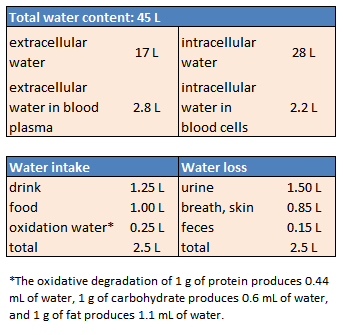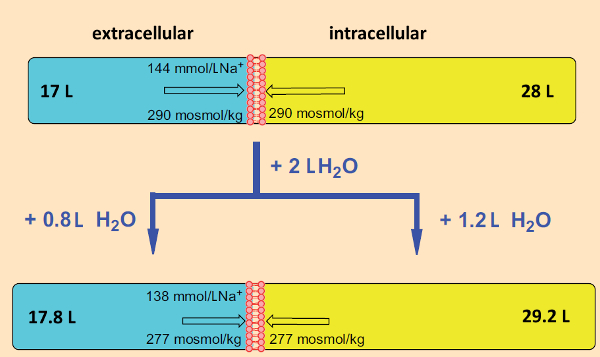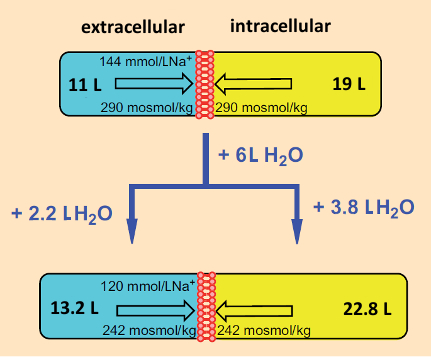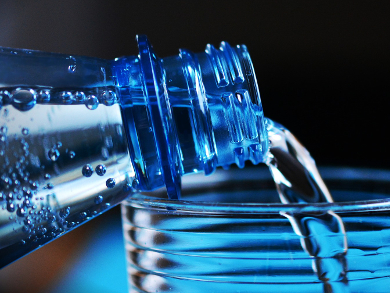In summer, people are often worried about potential dehydration. Out of fear of drying out internally, some people scarcely leave the house anymore without carrying a full two-liter water bottle. Paracelsus already warned us that it is only the dose that causes some things to be transformed into poisons. Let that be our starting point in examining whether water in excess might perhaps become poisonous. So we shall deeply immerse ourselves, conceptually, in a very large amount of water.
An adult human, in a moderate climate and under a normal amount of physical stress, loses about 2.5 liters of water per day via breath, the skin, feces, and urine (see Tab. 1). If this loss is not compensated, the person becomes “dehydrated”, and in a complete absence of water intake, would after a few days die of thirst. As protection against an inadvertent water deficit, the healthy adult can generally rely upon an ingenious, built-in regulatory system. In the case of children and senior citizens, however, there can indeed be a risk of undersupply of fluids.
|
Table 1. Water distribution and water balance for a person weighing 70 kg [1–2]. |
 |
On one hand, the release of the peptide hormone ADH (antidiuretic hormone) causes one’s urine to become more concentrated, and the normal loss of water is thereby reduced. At the same time, thirst—with all its disagreeable symptoms—urges one to attend to essential fluid intake. ADH, also known as vasopressin, is a nonapeptide. Its release from the posterior lobe of the pituitary gland is governed by sensors for osmotic pressure (osmoreceptors), located in the hypothalamus, and others for blood volume (baroreceptors) found in the right atrium of the heart and in the aortic arch.
Although our water balance remains exceptionally well adjusted lifelong, many people believe that under certain physical or psychological pressures, the internal controls can nevertheless fail, leading to a risk of dehydration. A true risk of dehydration occurs only after a water loss of more than 5 % of one’s body weight [3]. Typical symptoms include headaches and fatigue. Fluid loss of more than 10 % of one’s body weight, which is to say about seven liters of body water, becomes life-threatening. A common precaution to safeguard against the perceived danger of dehydration is a kind of self-medication: one drinks large amounts of water despite not feeling thirsty. Can this be dangerous?
1. Is Such a Thing as “Water Poisoning” Possible?
An inquiry into potential water poisoning at first seems utterly absurd. To begin with, simple survival requires the consumption of large amounts of water-containing food and drink on a daily basis. Even if we were to consume the full recommended daily water ration, cited in several sources as two liters, all at once, this would still present us with no real risk. The water thereby consumed would pass from the stomach via the intestines into the blood plasma, and from there be distributed rapidly over the entire body (see Fig. 1) [4]. The body would then swell, and concentrations of all dissolved bodily substances would decrease, along with the osmotic pressure.
 |
|
Figure 1. An osmotic look at a large gulp of water; top: Despite completely different electrolyte compositions, the same osmotic pressures are found in both intracellular and extracellular liquid regions [2]; bottom: After drinking 2 L of water, the liquid regions are swollen, and the extracellular sodium concentration has fallen slightly. |
Of special importance for our water and electrolyte budgets is a falling concentration of sodium ions in the extracellular fluids (e.g., blood plasma, lymph fluid, cerebrospinal fluid). After an intake of 2 liters of water, the sodium concentration typically falls from 144 mmol/L to 138 mmol/L, still remaining within the normal range. This is how we would manage to tolerate even this enormous gulp. In other words, for us, water is the best-tolerated foodstuff there is!
2. How Much Water Does a Person Actually Need?
Today it is generally assumed that an adult in a moderate climate, and not subject to extraordinary stress, should drink a minimum of two liters of water per day. But the source of this “wisdom” is obscure. The American Journal of Physiology sought clarification from the physiologist Heinz Valtin in 2002 [5]. His search proved to be in vain, and he suspected that the origin was not a formal study, but rather that a garbled citation had taken on a life of its own.
He found that a 1945 recommendation from the Food and Nutritional Board of the U.S. National Research Council stated: “The daily water requirement of an adult is generally ca. 2.5 L. … Most of this is already present in prepared meals.” In quoting this recommendation, however, the second sentence is frequently omitted, and so has fallen into obscurity. Thus, a “guideline for a total daily water intake of 2.5 L” has been transformed into a “recommendation to drink 2.5 L of water per day”.
Since one’s daily food intake typically already contains one full liter of water, and an additional 250 mL of water is derived from decomposition of this food within the body (see Tab. 1), for several decades the media has propagated a recommendation for drinking an amount of water that is twice what it should be. For years now, scientists [6–10] and, more recently, the media as well [11, 12], have begun to point out the excessively high value of the traditional rule of thumb. Nevertheless, people have tenaciously clung to the false notion that a person must every day drink at least two liters of water, and preferably more.
Contributing to highly overblown ideas regarding necessary water intake has also been the popular misbelief that caffeine-containing drinks are diuretics, and mustn’t be taken into account with respect to the water balance. This is simply false, a fact that was established scientifically years ago [13]. Overall, it makes no difference in the water balance whether one drinks water, coffee, tea, cola, lemonade, or fruit juice [14]. High-percentage alcoholic drinks, on the other hand, such as wine, aperitifs, liquors, and various spirits, actually do function as diuretics, and resulting water losses must indeed be compensated.
Let us therefore declare, along with the Deutsche Gesellschaft für Ernährung (German Society for Nutrition) that, given a normal diet and relatively light physical stress, a direct daily fluid intake through drinking of 1.5 L will definitely suffice [15]. Consuming modestly more will, for a healthy person, do no harm, since the kidneys can easily handle disposal of one or two extra liters of water over the course of a day. However, excess water also will not help. A spokesman for the Deutsche Gesellschaft für Nephrologie (German Society for Nephrology), Jan Galle, called attention to an especially sensitive bodily sensor, and formulated with sound common sense: “For the healthy, it is entirely sufficient to quench one’s thirst” [16].
3. At What “Dosage” Does Water Truly Become Toxic?
Despite how extremely well water is actually tolerated, it’s potential for toxicity is still of fundamental physiological significance. One measure of toxicity is the LD50 value: the one-time dose after ingestion of which 50 % of the test subjects (animals) die.
Since laboratory animals will not of their own volition drink absurd amounts of water, water for such a study must be delivered under narcosis, via a feeding tube. With this approach, Rowntree in 1926 [17] conducted a first study (one that today would be regarded as at least questionable) involving dogs, cats, rabbits, guinea pigs, and rats, all of which received large amounts of water. At the end of narcosis, many of the animals experienced severe gagging as well as muscle cramps.
It was not until 1956 that attempts were made to quantify the acute toxicity of water with respect to rats. The efforts were unsuccessful: while delivery of water at 90 g/(kg bw) (where bw = body weight) left all the rats in a pathetic condition, scarcely able to move, none actually died. In other words, no determination of a true LD50 value was possible [18]. Nevertheless, the above 90 g/(kg bw) figure was entered in a few databases as an LD50 value. Of course, toxicity studies on rodents can only be transferred to a very limited extent to humans, but they do offer at least an initial bit of guidance. A dose of 90 g/(kg bw) corresponds to the rapid consumption of six liters of water for a 70 kg human. But no one would be able to swallow such a large amount of water within a few minutes time.
There has nevertheless been no shortage of attempts, out of scientific curiosity, to consume as much water as possible, and to then measure resulting changes in blood pressure, pulse, urine output, etc. J. G. Priestley in 1916 drank three liters of water over a short period of time, and within the next few hours discharged exactly this same amount of urine, at a rate of up to 1.2 liters per hour [19]. In a publication of his findings, the researcher reported no health-related side effects. S. Amberg and R. B. Austin, two American dermatologists, drank the same amount of water in a study of the effect of water consumption on skin elasticity [20]. It was necessary to interrupt the work, however, since elastomeric measurement on the skin proved impossible due to violent and uncontrollable muscular twitches.
These to some extent heroic experiments showed that rapidly drinking three liters of water is evidently not life-threatening and instead “only” associated with substantial and unpleasant side effects. Therefore, inadvertent, serious poisoning with water can in the case of humans probably be ruled out; but not an intentional poisoning, since in contrast to all animals, people can force themselves—against all natural instincts toward feeling healthy—to consume enormous amounts of water, provided they are sufficiently motivated. A small selection of documented examples follows below.
4. Examples of Poisonings by Water
4.1. Water Poisoning Due to a Lack of Information
 In 2007, radio station KDND in California, USA, sponsored a water-drinking contest with 20 participants as part of its morning program. The winner stood to receive a very up-to-date—and at the time completely sold out in California—Nintendo Wii video game console. Under the motto “Hold your wee for a Wii”, the participants had to drink as much water as possible. Any contestant who went to the restroom during the process had to drop out.
In 2007, radio station KDND in California, USA, sponsored a water-drinking contest with 20 participants as part of its morning program. The winner stood to receive a very up-to-date—and at the time completely sold out in California—Nintendo Wii video game console. Under the motto “Hold your wee for a Wii”, the participants had to drink as much water as possible. Any contestant who went to the restroom during the process had to drop out.
To begin with, quarter-liter bottles had to be emptied at a 10-minute rate, where after only five bottles the first candidates had to give up. Then the size of the bottles was increased. The 28-year-old Jennifer Strange wanted absolutely to win the Wii for her three young children, and before giving up, drank more than six liters of water. While the program was still on the air she complained of a serious headache. In the end, she came in second, for which she won two tickets to a Justin Timberlake concert, and went home disappointed. There she died six hours later.
Let’s look more closely at changes in the body after drinking six liters of water. The slender Jennifer Strange normally had about 30 L of water in her body. The extra water she ingested resulted in an increase in water volume of 20 %. As a result, her extracellular sodium concentration fell to a perilous 120 mmol/L (see Fig. 2).
 |
|
Figure 2. The tragic death of Jennifer Strange. |
As noted, while drinking the added water she complained of a headache, together with dizziness and feeling ill. These are first indications of a brain swelling. The brain is so tightly enclosed in the bones of the skull that it has no possibility to expand. Pressure on the brain’s blood vessels, caused by swelling, leads above all to hindered blood flow. In a contest situation like that described, things are complicated by the fact that stress can cause a prolonged decrease in urination [21], so that the brain swelling may persist for hours. The end result here was death.
A woman caller during the program had warned that people can actually die from drinking too much water. Her warning was broadcast live, but it was treated by hyper-jolly hosts as a ridiculous idea [22]. Litigation lasting several years was initiated, and in the end, the radio station was forced to pay Jennifer Strange’s survivors 16 million dollars in damages.
All the cases of drinking too much water have followed a similar course. Distribution of the consumed water leads to a swelling of all tissues, and to plummeting sodium concentration in extracellular regions.
4.2. Water Poisoning through Misinformation
 An English girl, Leah Betts, celebrated her 18th birthday in 1995 at a club. During the evening she took a single ecstasy tablet (MDMA: 3,4-methylenedioxy-N-methylamphetamine). She danced a little, and chatted, mostly with her girlfriends. Later in the evening, she was feeling ill, which she ascribed to the ecstasy.
An English girl, Leah Betts, celebrated her 18th birthday in 1995 at a club. During the evening she took a single ecstasy tablet (MDMA: 3,4-methylenedioxy-N-methylamphetamine). She danced a little, and chatted, mostly with her girlfriends. Later in the evening, she was feeling ill, which she ascribed to the ecstasy.
The media had regularly promoted the idea of drinking water after taking ecstasy, so the young woman began to drink several glasses of water while still at the club. This recommendation originated in the idea of bodily stress, associated with continuous dancing in an overheated club after taking ecstasy. The high price of club drinks tends to also lead to the consumption of only small amounts of liquid under these circumstances.
After she got home, Leah continued to drink water—and ultimately collapsed. Later in a hospital, they determined that she had a critically low plasma sodium level of 126 mmol/L [23], which implied drinking several liters of water. Resulting swelling of the brain led ultimately to a coma, and then her death after five days. The cause of Leah Betts’ tragic death was therefore not an ecstasy tablet, but rather a self-induced over-dosing with water.
4.3. Water Poisoning Caused by Ignoring Information
 While the death of Jennifer Strange can be easily dismissed as a tragic isolated case, many instances of death involving recreational athletes demonstrate the result of limited knowledge regarding reasonable water intake in conjunction with physical peak performances. Marathon and ironman participants are especially at risk, because many of them adhere to the widespread and well-meant piece of advice to be sure and drink enough at water stations over the course of the race.
While the death of Jennifer Strange can be easily dismissed as a tragic isolated case, many instances of death involving recreational athletes demonstrate the result of limited knowledge regarding reasonable water intake in conjunction with physical peak performances. Marathon and ironman participants are especially at risk, because many of them adhere to the widespread and well-meant piece of advice to be sure and drink enough at water stations over the course of the race.
Here is the clinically well-documented case of a 36-year old ironman athlete [24]: At the beginning of the Kapstadt Ironman contest (3.8 km swimming, 180 km cycling, 42.2 km marathon run) the athlete in question weighed in at 81.6 kg, with a plasma sodium level of 144 mmol/L. He finished the race after 12 hours and 23 minutes, was dazed, felt ill, and therefore went to the medical tent.
He now weighed 85.5 kg and had thus gained almost 4 kg (!), so he must have drunk well over five liters of water during the race. This was confirmed by the low sodium value of 127 mmol/L. By four hours after the race, he had excreted only 500 mL of urine, even though after drinking large amounts of water people typically eliminate almost a liter per hour [25]. By the next morning, after admission to a hospital, he had produced 4.6 L of urine, and his sodium value had increased to 136 mmol/L.
By his own account, during the six-hour cycling event he had drunk about 750 mL of water per hour. During the subsequent marathon run, he felt somewhat sick and thought himself to be dehydrated. For this reason, he “drank as much as possible”. This was precisely the opposite of the message sports physicians had urgently recommended to all participants during the obligatory introduction prior to the race.
This case is representative of many such incidents, some of which have had fatal consequences [26, 27]. In contrast to sports-medically competent and individually looked-after professional athletes, amateur athletes sometimes enter into endurance contests with shocking recklessness [28]. Water is often consumed “according to instinct” at countless water stations.
A large-scale study involving 450 participants in the 2002 Boston Marathon revealed startling results [29]: 35 % (!) of the runners weighed more at the end of the race than at the start, with one participant having actually gained 4.1 kg (!). Their plasma sodium values correlated significantly with weight gains, with 13 % of the participants showing sodium values that were much too low (less than 135 mmol/L), and three participants (0.6 %) in fact revealing life-threatening values of 119, 118, and 114 mmol/L sodium in their blood plasma.
4.4. Water Poisoning Associated with an Extreme Diet
 One other group at risk is people engaged in a week-long diet program involving reduced food intake and large amounts of water, distributed over the day as a way of suppressing feelings of hunger [30]. Of course, a correspondingly high level of urination periodically acts to restore the daily water balance, but electrolytes, especially sodium, are eliminated with the urine. This means that one’s overall reservoir of sodium is slowly—but steadily—reduced, since given the sharply curbed food intake, insufficient amounts of electrolytes are being consumed. In the end, critically low sodium values are reached. Two examples illustrate the bandwidth of human foolishness:
One other group at risk is people engaged in a week-long diet program involving reduced food intake and large amounts of water, distributed over the day as a way of suppressing feelings of hunger [30]. Of course, a correspondingly high level of urination periodically acts to restore the daily water balance, but electrolytes, especially sodium, are eliminated with the urine. This means that one’s overall reservoir of sodium is slowly—but steadily—reduced, since given the sharply curbed food intake, insufficient amounts of electrolytes are being consumed. In the end, critically low sodium values are reached. Two examples illustrate the bandwidth of human foolishness:
In 2008, after a twelve-week 500 kcal “LighterLife” diet plan, Jaqueline Henson (49) from the United Kingdom was able to replace the scheduled meals with a light soup or simply water. In the first week after this change, she had already lost 5 kg. In the second week, when she began drinking two 2-liter bottles of water while watching television, she complained of head and stomach pains and didn’t feel well in general. Soon thereafter she collapsed and died the next day in the hospital of cerebral swelling [31].
The British actor Anthony Andrew (55) in 2003 played the role of Professor Henry Higgins in “My Fair Lady” in the London West-End Theater Royal. He was in the habit of drinking several liters of mineral water over the course of a day. During one day that included both a matinee and an evening performance, he ended up drinking over 8 liters. He complained of a headache, dizziness, and nausea, and first signs of neurological disorders and orientation trouble were observed. After the evening performance, he collapsed and fell into a three-day coma. Following a prolonged stay in the hospital, followed by a lengthy recovery, he was eventually able to return to the stage [32].
References
[1]G. Löffler, P. E. Petrides (Eds.), Biochemie und Pathobiochemie (in German), Springer, Heidelberg, Germany 2003. ISBN: 9783540326809
[2] R. F. Schmidt, G. Thews (Eds.), Physiologie des Menschen (in German), Springer, Heidelberg, Germany, 1997. ISBN: 9783540667339
[3] A. C. Grandjean, Water Requirements, impinging factors, and recommended intakes, www.who.int, 2012.
[4] A. C. Guyton, Human Physiology and Mechanisms of Disease, W. B. Saunders, Philadelphia, USA, 1987. ISBN: 9780721632995
[5] H. Valtin, “Drink at least eight glasses of water a day.” Really? Is there scientific evidence for “8 x 8”?, Am. J. Physiol. Regul. Integr. Comp. Physiol. 2002, 283, R993. https://doi.org/10.1152/ajpregu.00365.2002
[6] A. C. Grandjean et al., The Effect on Hydration of Two Diets, One With and One Without Plain Water, J. Am. Coll. Nutr. 2003, 22, 165.
[7] S. M. Campbell, Hydration needs throughout the lifespan, J. Am. Coll. Nutr. 2007, 26, 585.
[8] S. D. Negoianu and S. Goldfarb, Hormonal and Thirst Modulated Maintenance of Fluid Balance in Young Women with Different Levels of Habitual Fluid Consumption, J. Am. Soc. Nephrol. 2008, 19, 1041. https://doi.org/10.3390/nu8050302
[9] M. McCartney, Total volume and composition of fluid intake and mortality in older women: a cohort study, Brit. J. Med. 2011, 343, 4280. https://doi.org/10.1136/bmjopen-2016-011720
[10] C. Williams, Health myths: Drink eight glasses of water per day, New Scientist, August 24, 2013.
[11] R. Thielicke, Viel Wasser nützt wenig (in German), Focus Magazin 2008, 15.
[12] B. Fersch, Trinken: Hören Sie auf Ihr Durstgefühl (in German), www.apotheken-umschau.de, October 24, 2012.
[13] A. C. Grandjean et al., The effect of caffeinated, non-caffeinated, caloric and non-caloric beverages on hydration, J. Am. Coll. Nutr. 2000, 19, 591.
[14] S. M. Campbell, Hydration needs throughout the lifespan, J. Am. Coll. Nutr. 2007, 26, 585.
[15] More precise and age-adapted recommendations for children, women, and men from the Deutsche Gesellschaft für Ernährung (German Society for Nutrition, in German), www.dge.de.
[16] cited in [11]
[17] L. G. Rowntree, The Effects on Mammals of the Administration of Excessive Quantities of Water, J. Pharm. Exp. Therap. 1926, 29, 135.
[18] E. Eagle and C. E. Poling, Effects of Feeding Polyoxyethylene Preparations to Rats and Hamsters, J. Food Science 1956, 21, 348. https://doi.org/10.1111/j.1365-2621.1956.tb16930.x
[19] J.G. Priestley, The regulation of the excretion of water by the kidneys, J. Physiol. 1916, 50, 304.
[20] S. Amberg and R. B. Austin, loc. cit. in [17]
[21] K. Michael in Anästhesie und Intensivmedizin (in German), Springer Verlag, Heidelberg, Germany, 2006. ISBN: 9783540627395
[22] S. Wilson, The Jennifer Strange Story, www.youtube.com, 2012.
[23] J. Laurance, The Times, November 22, 1995.
[24] T. D. Noakes et al., Weight changes, medical complications, and performance during an Ironman triathlon, Brit. J. Sports Med. 2004, 38, 718.
[25] T. D. Noakes et al., Peak Rates of Diuresis in Healthy Humans during Oral Fluid Overload, S. Afr. Med. J. 2001, 91, 852.
[26] Doctors: Marathoner Died From Too Much Water, www.wcvb.com, August 13, 2002.
[27] D. Q. Wilber, D. Brown, District Officer Dies After Bike Ride, The Washington Post, August 11, 2005
[28] T. D. Noakes, Water Intoxication—Considerations for Patients, Athletes and Physicians, Pract. Gastroent. 2008, 46.
[29] C. S. D. Almond et al., New Engl. J. Med. 2005, 352, 1550.
[30] A. Trousseau, Lectures on Clinical Medicine 1870, 1, 528.
[31] Woman died from ‘too much water’, news.bbc.co.uk, December 12, 2008.
[32] E. Grice, My battle with the bottle, The Telegraph, August 21, 2003.
The article has been published in German as:
- Dehydrierung: Die Angst geht um,
Klaus Roth,
Chem. Unserer Zeit 2014, 48, 332–340.
DOI: 10.1002/ciuz.201400688
and was translated by W. E. Russey.
Can Too Much Water Be Toxic? – Part 1
Is such a thing as “water poisoning” possible?
Can Too Much Water Be Toxic? – Part 2
How can water cross cell membranes? Fascinating chemistry that affects each one of us
See all articles by Klaus Roth




